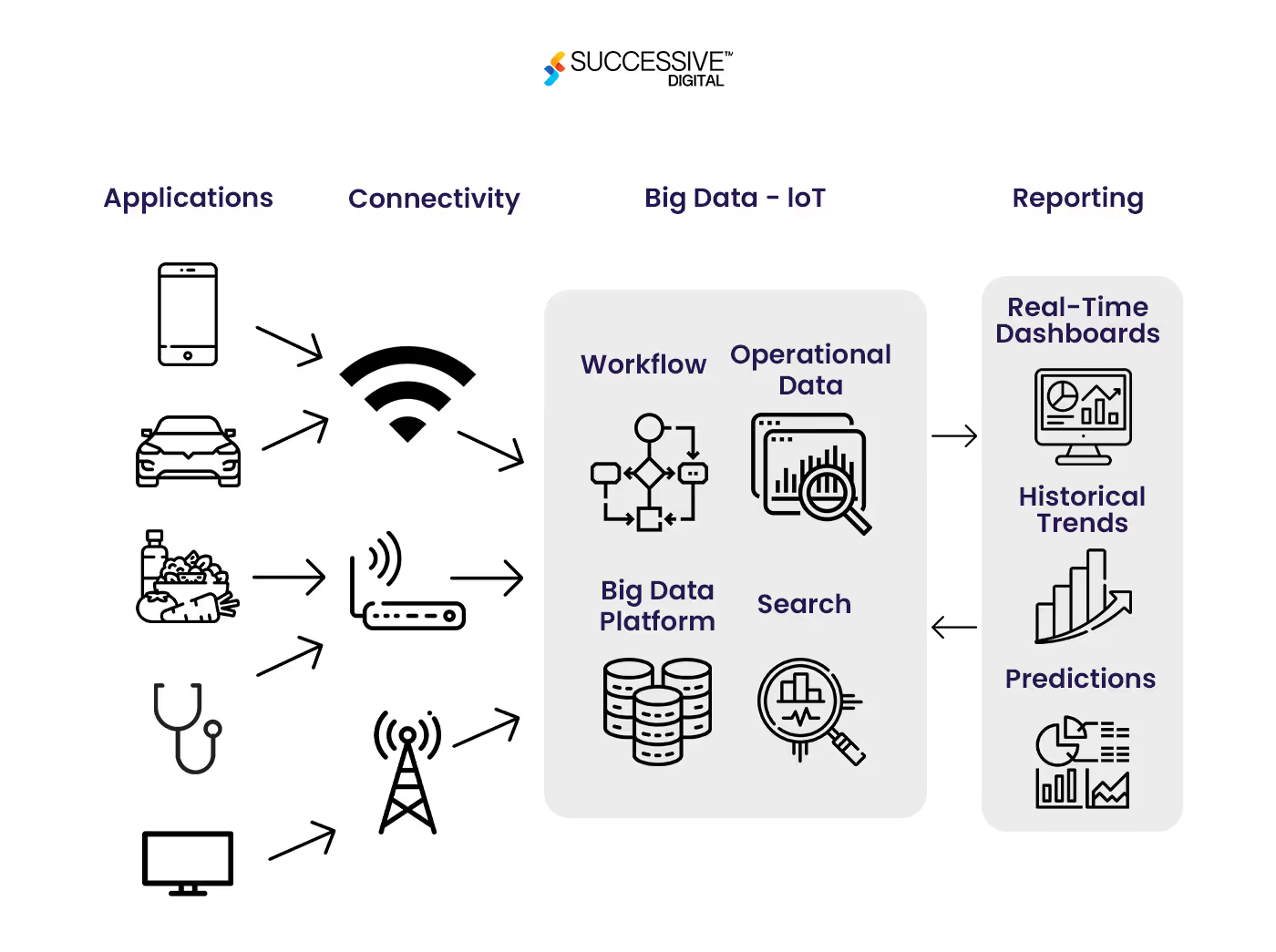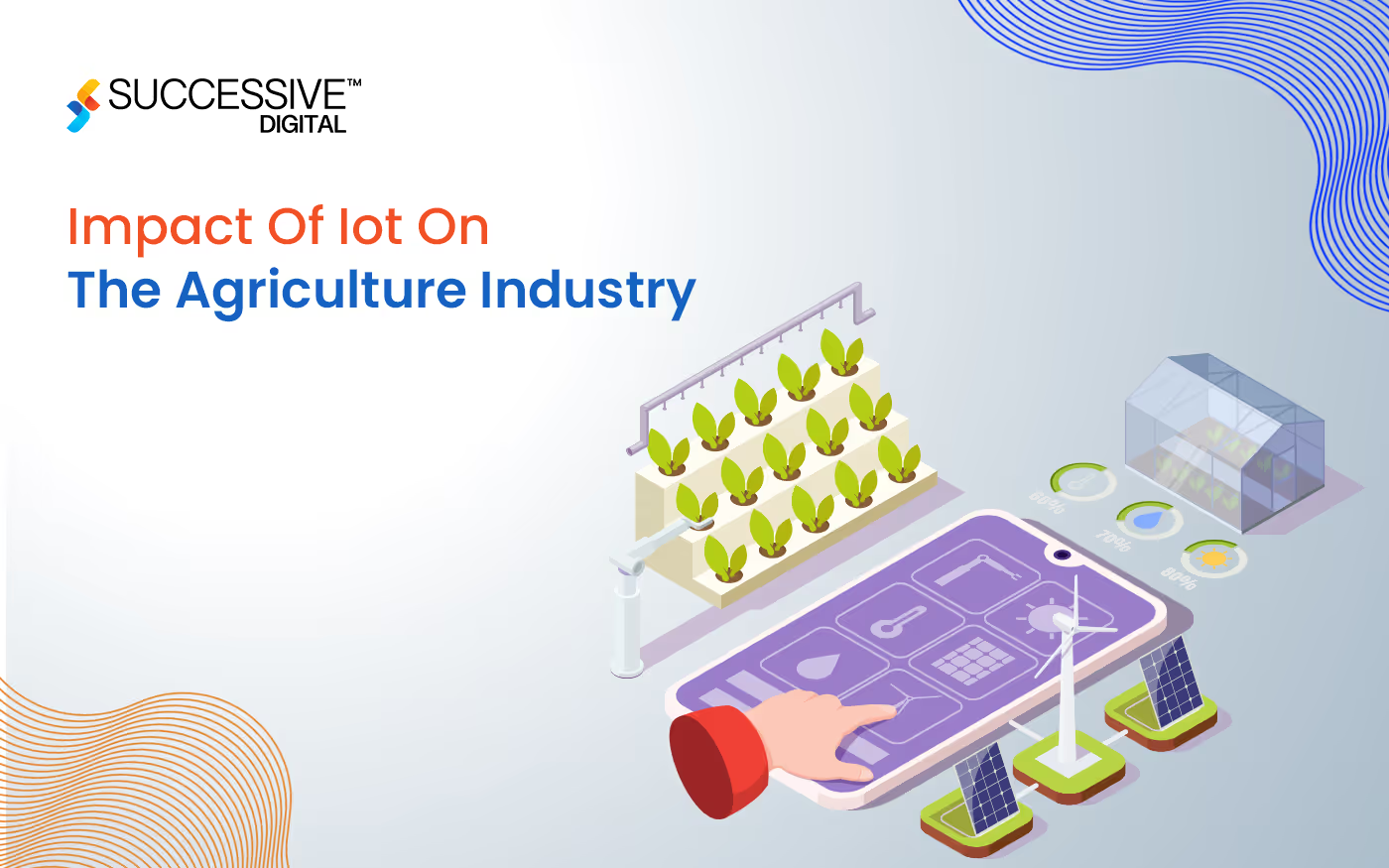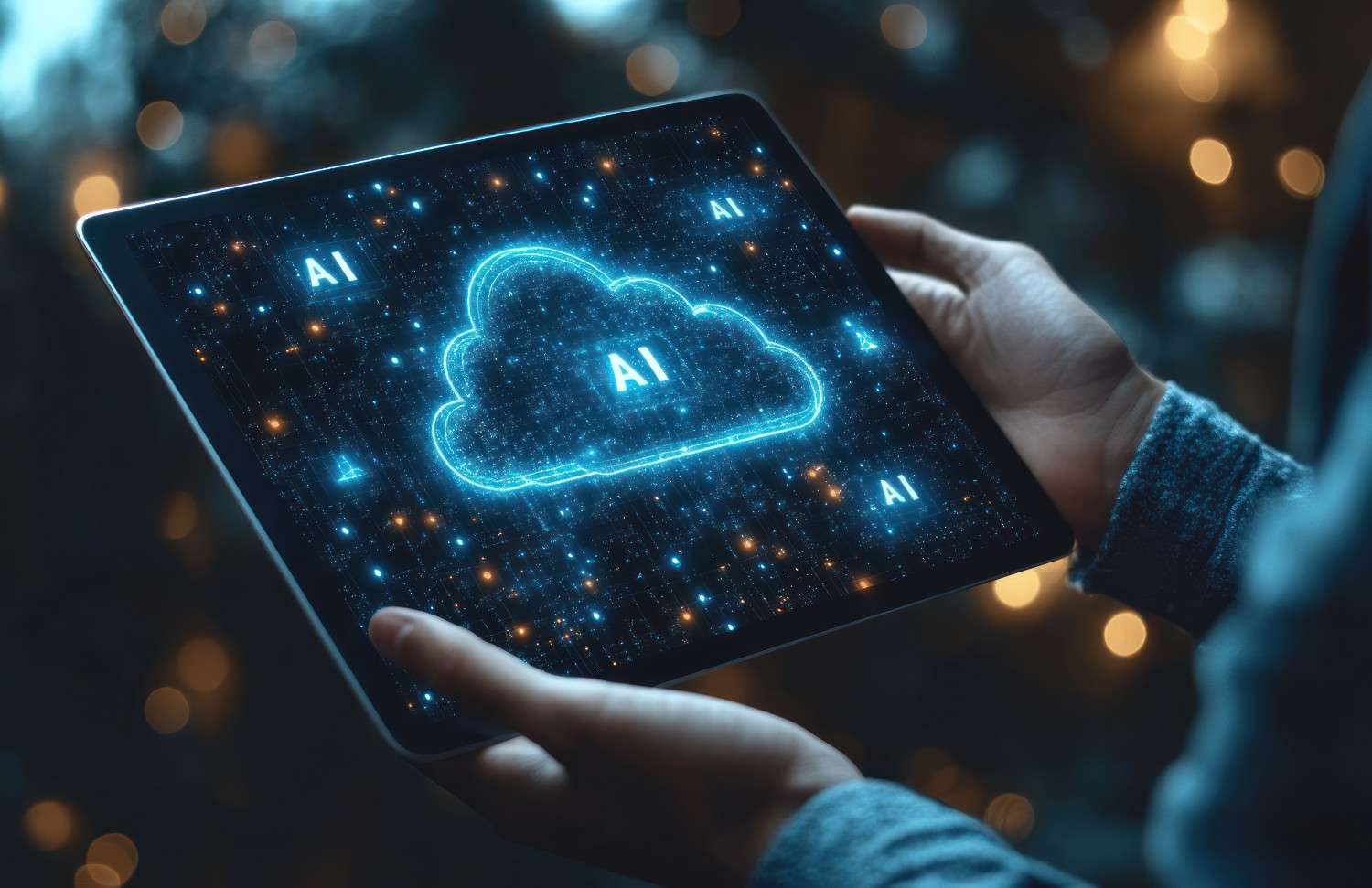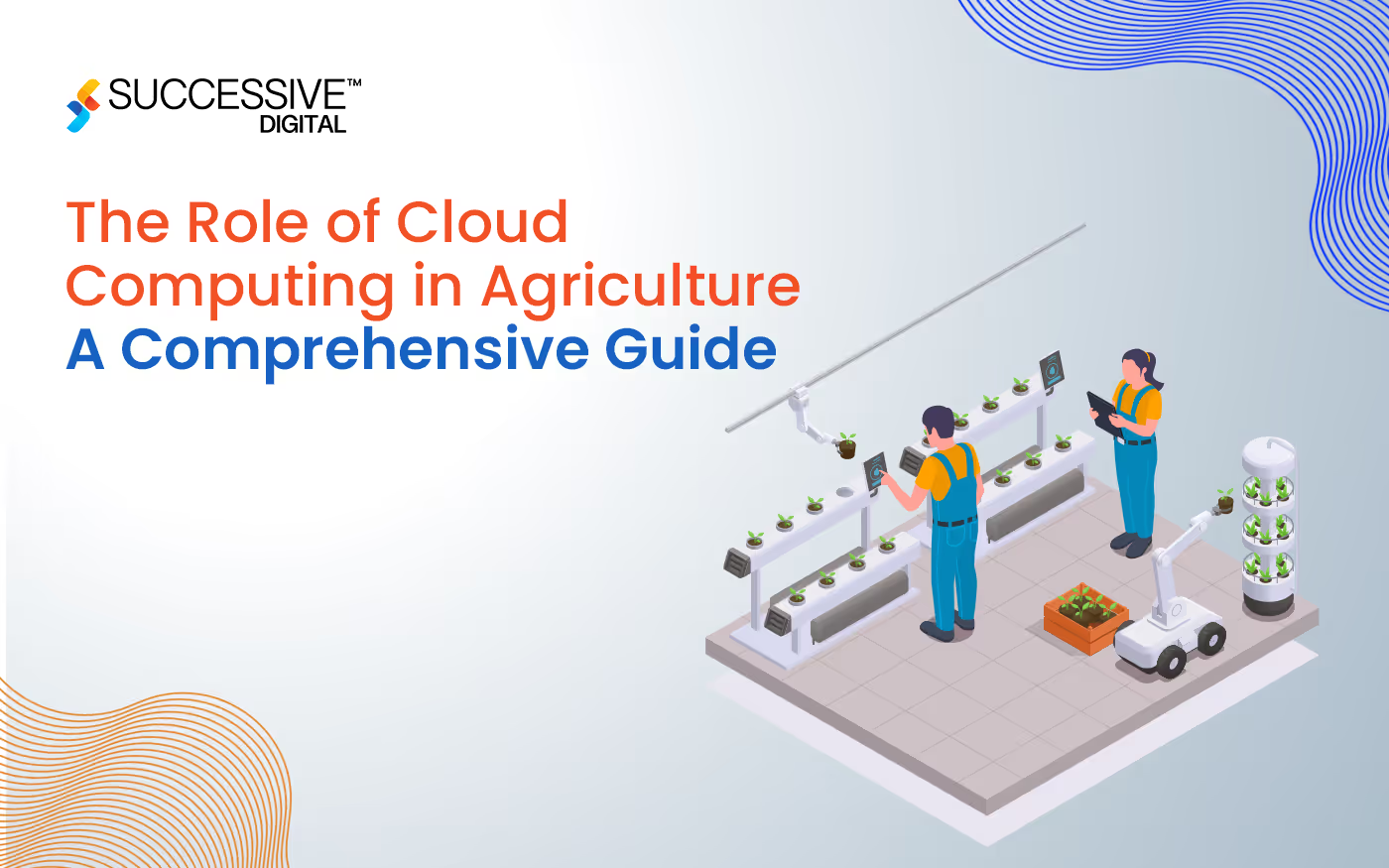Farming worldwide has come a long way from the traditional, not-so-efficient manual methods of growing crops to large-scale, automated cultivation methods that combine machinery, drones, smart devices, AI, and IoT devices to result in high yields. Agriculture is now in the early days of another revolution, which we know as smart farming. Data and connectivity across the farming value chain are at the heart of this. Smart IoT farming is the future of agriculture, promising to improve the operations of farmers worldwide greatly. A huge part of smart farming involves using IoT technology to monitor crop fields using sensors and automated irrigation systems.Trends show that the IoT market size in agriculture can grow from $11.4 billion in 2021 to $18.1 billion by 2026.But what is driving the adoption of IoT in agriculture? This blog answers the question along with some proven agriculture IoT solutions use cases.
What is the Internet of Things (IoT)?
The Internet of Things (IoT) is the most productive and essential methodology for building a smart and connected ecosystem for any industry.The system works by connecting digital and physical devices to the Internet, enabling remote monitoring and control. This technology facilitates effective management, enhances ease and safety, and offers insightful data captured through a number of building blocks, such as:
- Sensors
- Applications
- Network elements
- Supporting electronic devices
How Does IoT Work?
IoT starts working when the devices (like smartphones, electronic appliances, and sensors) are connected securely with an IoT platform. These devices collect data and communicate it to the IoT application for analysis, reducing the volume of data sent to the cloud. The data is now made ready to be sent to the cloud through a variety of methods, including:
- Cellular
- Satellite
- WiFi
- Bluetooth
- Low-power wide-area networks (LPWAN),
- Or connecting directly to the internet via ethernet
Once the data is transferred to the cloud, the software processes it. This might be as basic as ensuring that the temperature reading is within limits. Each system within the IoT ecosystem interacts with each other and with the IoT platform to enable a network of interconnected devices capable of making decisions autonomously. Next, the information is made useful to the end-user in some way. This could be via an alert to the user (email, text, notification, etc).
What Is The Impact of IoT in Agriculture?
The Internet of Things and agriculture establish a network among physical devices, applications, and farms through sensors, software, and network connectivity that allows them to collect data. This technology is used to optimize farming operations as part of a smart farming model. A significant reason for the increased adoption of IoT in agriculture is the resilience and reliability of IoT applications, even in the absence of cellular networks or Wi-Fi signals. Agriculture IoT provides support to farmers even from space. Many IoT devices are compatible with Long-Range WAN (LoRaWAN) satellite coverage to increase connectivity for low-coverage areas. This promotes seamless data transmission over vast distances and empowers farmers to gather data that enables them to make informed decisions, such as
- Irrigation
- Fertilization
- Harvesting schedules
- and more to improve crop yield and monitor water usage, even in low connectivity zones.
How Is the Internet of Things (IoT) Used in Agriculture?

IoT is used in agriculture to support smart farming techniques by adopting advanced technologies and data-driven farm operations to improve sustainability and yield produce.In farming, IoT technologies are implemented through sensors, robots, drones, devices, and data analysis, as mentioned below.
IoT Sensors
IoT sensors are used in various agricultural processes by embedding them in soil, crops, machinery, and livestock. These sensors monitor various parameters critical for agricultural operations.These IoT-enabled Sensors are primarily used to collect data in real-time on crop health, plant density, irrigation needs, soil conditions, temperature, humidity, and nutrient levels. Within agriculture, IoT devices include many kinds of IoT sensors, such as:
- Sensors for monitoring crops
- Cattle and livestock tracking devices
- Sensors for observing the condition of farm equipment
- Weather station sensors
Robotics
Robotics or agrobots are heavily used in agriculture to fulfill labor shortages and increase efficiency in crop production.Common IoT-enabled robotics and machines that are used in agriculture are,
- Harvesting machines
- Tractors
- Planting robots
- Seeding robots
They operate without human intervention and can be fully controlled through agriculture IoT solutions. These robots are used for tasks like weeding, machine navigation, and harvesting, enhancing productivity and reducing operational costs.
IoT enabled Drones
IoT-connected drones enable precision farming and enhance crop quality. They are equipped with specialized cameras and sensors to monitor crop health in real time, detect diseases, and identify pests. These drones, built on an advanced level, can even precisely spray pesticides, herbicides, and fertilizers on targeted areas that are most often difficult for humans to access. Through IoT-enabled drones, farmers and agronomists can reduce waste and costs compared to manual spraying. Drones in agriculture collect data on various parameters, such as:
- Crop health
- Irrigation
- Spraying
- Planting
- Soil conditions
- And field mapping
This data is analyzed to derive insights for optimizing farming practices and improving crop quality.
Use Cases of IoT in Agriculture
Combining the Internet of Things and agriculture is crucial to achieving major agro goals on a global level, such as
- Boosting agricultural productivity
- Producing quality yields
- Fulfill the demand-supply balance
- Cater to the ever-growing demand for food.
IoT in the agriculture industry involves incorporating IoT-based technological systems, tools, solutions, equipment, and their supporting IoT applications to maximize yield, improve operational efficiency, and reduce wastage of energy. Here are some of the use cases of IoT in agriculture industry.
- Sensing Capabilities In Precision Farming
Precision farming is a smart agriculture concept based on observing and responding to field variations. Through precision farming, IoT in agriculture offers various ways to improve crop observation and care by providing crops with a precise amount of fertilizers, water, and pesticides and creating favorable weather conditions. By getting timely crop updates through IoT-enabled solutions, farmers can predict and react to conditions quickly and offer multifaceted analysis of farming processes.Integrating weather data, irrigation, nutrients, and other systems improves resource use and boosts yields by more accurately identifying and predicting deficiencies. Drones gather images from remote corners of fields, assisting farmers in making more informed and timely decisions and getting early warnings of problems like disease or pests.Nonetheless, IoT in agriculture enables farmers to monitor and optimize harvesting remotely through sensors. These sensors also monitor crops for quality characteristics — say, sugar content and fruit color—that help farmers maximize the revenue from their crops.
- Yield Monitoring And Crop Management
Smart monitoring through IoT could help agribusinesses optimize the harvesting window by viewing the crop condition remotely through an application. Agriculture IoT devices collect data on factors like soil moisture, temperature, and plant health contributing to crop health. The crops are monitored timely throughout the growing process on various parameters such as:
- Soil conditions and type analysis
- Nutrient level analysis
- Pest infestations
Data collected on these parameters help agronomists develop effective crop management strategies from sowing to harvesting. Agriculture IoT solutions also provide frost warnings, irrigation alerts, or intrusion detection at any time of the day and night for continuous monitoring, notification, surveillance, and protection of the crops.
- Greenhouse Management
Monitoring the greenhouse environment is crucial to maintaining favorable conditions for plant growth. Smart greenhouses are equipped with sensors that optimize plant growth by regulating heat, humidity, and light, providing required air quality monitoring and ventilation. The sensors detect certain conditions that are ideal for the plants and help greenhouses reduce energy and water consumption, making the entire greenhouse run process more efficient.Using the IoT in agriculture establishes a sensor network where farmers can monitor the conditions in their greenhouses in different places around the country or even the world based on native plantation growth requirements. Its wireless technology allows soil moisture sensors, humidity sensors, temperature sensors, and other sensors to connect to the internet and have a web connection, which can be remotely controlled to make changes in the greenhouse ecosystem.
- Smart Irrigation Systems
One of the most common applications of IoT in agriculture is building a smart irrigation system. The farmers can access and track moisture levels in the soil through these irrigation systems.IOT-based drip Irrigation system ensures precise irrigation and nutrition based on crop type, stage, and location by taking inputs from sensors, previous year data, satellite images etc. Based on the analysis, the system determines the optimal irrigation schedule, sprinkler systems and water required for the specific crop and soil conditions.These agriculture IoT-based automatic irrigation systems are connected through a supported application that helps farmers and agronomists monitor and manage the use of water resources in agriculture.
- Efficient Livestock Management
IoT devices sense the variable physical quantities (VPQ) like humidity, light intensity, and temperature to manage livestock on a large scale in animal farms with smart technologies.Preventing disease outbreaks and spotting animals in distress is critical in large-scale livestock management, where most animals are raised in close quarters. Here, IoT-enabled chips and body sensors measure temperature, pulse, and blood pressure and can easily detect illnesses early, preventing herd infection and improving food quality. In many parts of the world, farmers are already using Iot in agriculture through ear-tag technology, which monitors cows’ heat, health, and location.
- Predictive Analytics For Improved Resource Planning
Predictive analytics utilizes data and algorithms to make predictions about future events. In agriculture, predictive analytics can be used to determine the optimal time to harvest crops.Agriculture IoT solutions capture data and make it available in the simplest form all the time, this way, the data is readily available to use for making predictions. With real-time data, agronomists can predict when the crop will reach its peak yield plan resources while keeping the futuristic approach in mind when planning harvesting schedules.
- Smart Warehousing and Supply Chain Management
Smart warehousing and supply chain management is another application of IoT in agriculture, and the most crucial one, as traditional warehousing and traceability measures lack automation. This leads to items getting damaged, lost, and even adulterated on the way to the market/consumer. Here, agriculture IoT solutions streamlines the collection and analysis of large amounts of data on various aspects of the agri-supply chains by planning, managing and tracking agro-produce operations, farm to plate. Final WordsIoT in agriculture creates a connected farming ecosystem from soil to satellite. A fair adoption of agriculture IoT solutions can vastly improve farming practices and contribute to more sustainable agriculture, which is critical to tackling the global climate crisis.As a leading agritech software development company, Successive Digital prioritizes easy adoption of IoT solutions across the agriculture chain with easy-to-navigate, scalable, and secure solutions that can be easily integrated with IoT devices.With a strong technical foundation, our team promotes sustainability by helping farmers and agronomists adopt eco-friendly IoT solutions that accurately collect and measure data and transform it into insights to help farming make the best decision at the right time with convenience.
.avif)










.jpg)









